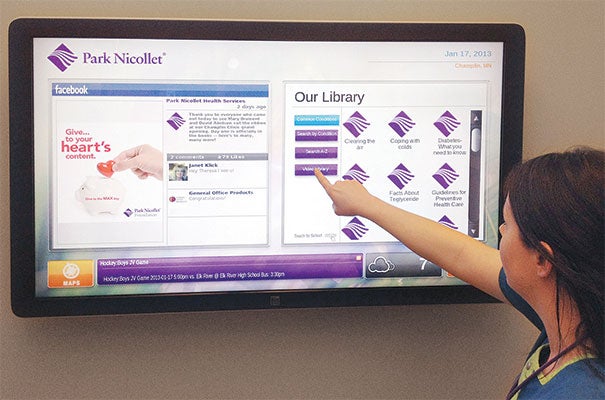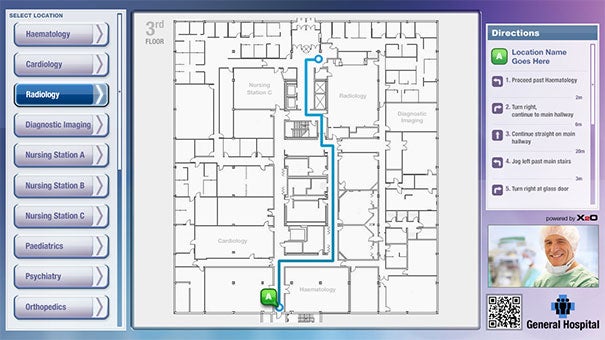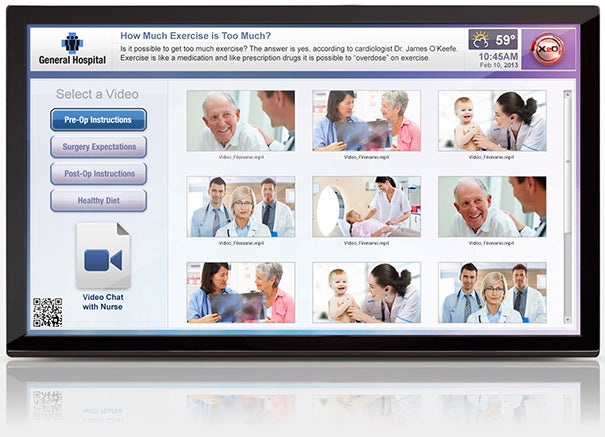Visual communication improves patient experience
Traditionally, visual communications in health care facilities have been limited in their scope. Typical display points offering static information are designed to meet a simple communication objective: inform patients and medical staff of internal events and basic facility information. Although this base-level objective is integral to any health care network, it represents only a narrow portion of what can be achieved through visual communications.
 |
| Photo courtesy of X2O Media The visual communications network at Park Nicollet Clinic - Champlin augments the patient and guest experience by delivering on-demand video content, interactive wayfinding, and real-time social media updates. |
Enhancing the experience
The emergence of a new generation of dynamic tools and infrastructures allows hospitals and clinics to transform their digital signage installations into content networks, adding value to their services while enhancing the experience for patients and visitors. Featuring pertinent and entertaining information can improve a patient’s stay, especially if that information is tailored to them. Applications that patients find helpful and can be optimized through visual communications include:
• Wayfinding. Anyone who has ever found themselves hopelessly lost in the myriad hallways of a hospital or clinic knows that health care facilities aren't always the easiest places to navigate. To help, digital wayfinding is an option that uses interactive digital displays to provide step-by-step navigation to patients and visitors, allowing users to orientate themselves easily within large premises and campuses. By means of multitouch technology, today’s wayfinding displays allow users to look up physician directories as well as browse, search and plan directions quickly across extensive campuses, while 3-D images provide a more realistic depiction of the trajectory. Furthermore, by scanning QR codes directly from displays or utilizing other mobile technologies such as near-field communication, visitors can download detailed instructions, maps and directories directly onto their mobile devices – providing a truly interactive experience that marries portability with customized mapping information.
The interactive wayfinding screens also provide an opportunity for the health care facility to promote local happenings, such as a blood drive. They also can highlight other facility services, such as a coffee shop or pharmacy that the patient may not be aware of that are close to the route they’ve selected. This additional content can be presented in an unobtrusive way in which the patient has the option to select the location for more information, leaving the decision-making in the hands of the patient or visitor.
• In-room patient channels. The push model of preselecting content for TV delivery is quickly becoming a thing of the past. Via new technology, patients can leverage advanced visual communications networks, allowing them to control their own in-room experience by choosing from a wide range of materials that have been created to enhance their stay. In addition to social media, news and staff information, health care facilities are now providing patients with a variety of on-demand health videos and reading materials that can be tailored to their specific condition or treatment. There also is a wide range of entertainment choices provided to patients and their families to reduce anxiety. For instance, children’s videos and games are options that allow a parent who is recovering from a procedure to spend time with children without exerting themselves too much. These resources help patients prepare for medical procedures and support their recovery process, creating efficiencies for hospitals, as well.
• Health care content channels. Many health care facilities are turning their static information points into digital channels in which a wide range of externally fed content can be seamlessly distributed to viewers. For example, in smaller facilities where visitors often wait in lobbies, guests can browse through staff bios, read up on medical facts, view local weather forecasts, view current social media content and catch up on the latest news via local news tickers. Similarly, the anxiety of waiting for a procedure in waiting rooms can be alleviated with digital channels that play “lighter” content supplemented with local news and community events.
Because the digital screens in a facility or throughout a campus are connected via networking, digital communication becomes a very powerful medium to broadcast emergency messages. These can be pre-programmed messages at the ready, with permission to launch an emergency alert limited to relevant staff such as security personnel. These alerts could be targeted to a specific section of a floor, an entire floor or building, or, if serious enough, could also be broadcast campus-wide.
 |
| Photo courtesy of X2O Media Interactive wayfinding allows visitors to navigate a single building or multicampus health care facility quickly and even download directions directly to their mobile devices. |
Streamlining workflows
The benefits of interactive digital signage are not limited to patients and visitors. Health care networks can leverage the tool to produce greater efficiency and communication among staff by focusing on key areas.
• Collaboration. Today’s visual communications solutions bring exciting new possibilities for collaboration to medical and support staff. Using applications that allow instant, live, two-way video communication directly from patient rooms, doctors can provide remote advice regardless of location, which allows health care facilities to expand their reach and further streamline their workflows. Conversely, patients also can page support personnel via digital displays equipped with cameras for quick, face-to-face interaction. This enables on-duty staff to supervise larger areas of hospital facilities and, in the case of non-urgent interventions, to do so without leaving their stations. Collaboration also extends to more critical environments such as operating rooms where surgical staff can be called in to provide offsite expertise or simply to supervise subordinate teams. Similar applications also have proven useful during training sessions – enabling content to be broadcast beyond the walls of the operating room or recorded for subsequent study sessions.
Dynamic visual communications deployed on large video walls in a health care facility’s presentation rooms enhance staff collaboration, allowing discussion to occur both locally and remotely regarding patients’ conditions, medical documents and more. In addition, these video walls can be used for patient/doctor consultations as well as visitor edification to show how the clinic or hospital functions, for example. Through use of powerful visuals, users are able to communicate on another level like never before.
• Administrative tools. New visual communications software also brings resource planning efficiencies to health care settings by offering more graphical, intuitive and dynamic processes. For example, health care facilities could easily combine digital room and resource scheduling screens with internal news bulletins for staff members. Digital screens can automatically display calendars that are linked to room reservation systems or applications such as Microsoft Outlook. Rooms and resources can be booked directly from the interactive screens or on a PC and be fully synchronized with displays.
Digital displays also provide staff and administrators with a quick and easy way to view staff shift schedules, which can be quite complex to manage within broad organizations. These staff schedule boards could be supplemented with staff bulletins and other information that may be relevant, such as current local weather or traffic conditions. By reducing the complexity linked to coordinating, scheduling and informing large bodies of staff that operate on a rotating basis, administrators have more time to spend on other activities.
 |
| Photo courtesy of X2O Media Digital screens allow patients to control their own in-room experience by choosing from a wide range of materials that have been created to enhance their stay. |
Best practices
The mission driving a visual communications program may vary from facility to facility. For instance, the needs of an outpatient clinic differ from those of an acute care hospital. However, those seeking to optimize this resource should follow best practices that apply to health care facilities across the spectrum.
• Avoid wallpaper. It's important to display highly focused content that truly resonates with viewers, transforming the network into a resource that patients and visitors come to rely on and trust. It is tempting to schedule irrelevant content simply to ensure that there is always something on the screen. This is known as "wallpaper" – generic content that is readily available and usually relatively inexpensive that "papers" over the screen, ensuring no black appears. This type of content, however, should be avoided, as it does little to enhance messaging and the overall objectives of the network,
• Branding. Equally important to content selection is visually conveying the facility's brand with design elements like color schemes, animations and music, which communicate to viewers that they are watching or interacting with a unique channel that has a specific purpose. For example, television networks use strong, easily recognizable graphics and music to clearly distinguish themselves. In all visual communications, the style presented on-screen gives the network a sense of identity, which plays two important roles. It stresses the exclusiveness or “specialness” of the network while promoting the unique content it delivers, and it quickly and effectively communicates the network’s brand personality by giving it a distinctive “voice.”
• Production values. A network must be consistent in its production values. It is important that content is purposefully produced and programmed to achieve a sense of flow and a certain commonality of themes and ideas. In addition, technical standards need to be set and adhered to for video and audio quality. Today’s audiences are more sophisticated than ever when it comes to the look and feel of content on their screens, so the bar has significantly been raised for visual communications. Viewers instantly know what looks professional and what doesn’t, and if they feel the presentation is subpar, that negative first impression will reduce the network's effectiveness.
• Content management. The management of content is critical to a visual communications network's success. An easy-to-use content management system with simple drag-and-drop tools should be utilized and made accessible to as many staff members as possible, including doctors, nurses and other personnel. Because videos and other information on in-room screens should be specific to the patient currently in the room, it is often doctors and nurses who upload content based on their patient’s condition. They must be able to do so quickly without assistance from the IT department, freeing them up to spend more time with patients and deliver the best possible care.
Major innovations
Major innovations within the visual communications space are changing the way information is distributed, experienced and shared within the health care sector. As a result, institutions of all sizes – from community-based clinics to regional hospitals – can create more customized experiences for patients, increase the efficiency of their operations and improve the overall quality of their services. Using a combination of easy drag-and-drop content creation tools, design best practices and mobile integration, today’s visual communications solutions are poised to radically transform the way displays enhance environments, especially when critical interactions are at stake.
Jay Martin is director of U.S. sales for X2O Media, a provider of software for real-time visual communications applications. He can be reached at jay.martin@barco.com.




